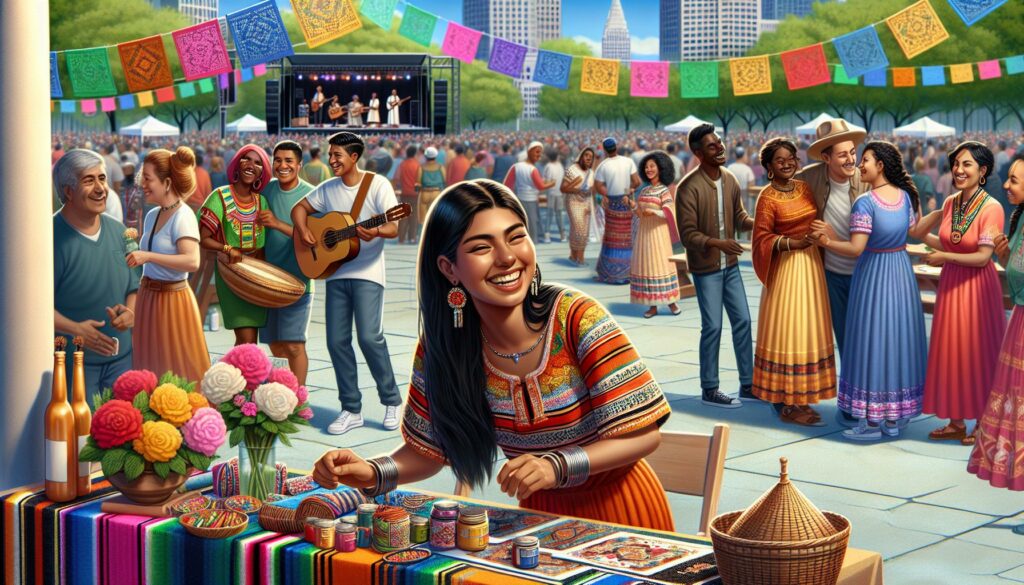As a parent and cultural educator I’ve seen firsthand how exploring different traditions and customs can spark curiosity in children. Cultural activities for Kids open up exciting new worlds while teaching kids valuable lessons about diversity acceptance and global understanding.
I love watching young minds light up when they discover the vibrant colors of Holi celebrations or learn traditional African drumming patterns. These hands-on experiences go beyond typical classroom learning to create meaningful connections with different cultures. Whether it’s cooking international recipes making cultural crafts or participating in traditional dances kids develop appreciation for our wonderfully diverse world through fun and engaging activities.
Key Takeaways
- Cultural activities enhance children’s cognitive development and create lasting neural connections through hands-on experiences with diverse traditions
- Arts and crafts from different cultures, like origami and block printing, help develop fine motor skills while teaching kids about global artistic expressions
- Music and dance activities build coordination skills and cultural appreciation through exploring traditional instruments and learning authentic dance movements
- Cooking international recipes helps children connect with different cultures while developing practical kitchen skills and understanding diverse culinary traditions
- Traditional games and sports from various cultures teach cooperation, social dynamics, and physical coordination while strengthening cultural connections
- Cultural storytelling and festival celebrations create immersive learning experiences that help children understand and appreciate global traditions while building language skills
Cultural Activities for Kids
Cultural activities for kids shape children’s cognitive development by exposing them to diverse perspectives through hands-on experiences. These activities create lasting neural connections that enhance learning across multiple developmental domains.
Building Cultural Awareness and Identity
Cultural activities strengthen a child’s sense of self while developing respect for others’ traditions. I’ve observed children gain confidence in sharing their heritage through activities like traditional storytelling sessions cultural fashion shows. These experiences help children:
- Connect with their family history through ancestral recipes cooking sessions
- Express cultural pride during show-and-tell presentations of cultural artifacts
- Develop positive self-image by celebrating unique customs holidays
- Learn respectful ways to ask questions about different traditions practices
- Developing cross-cultural communication skills through multilingual activities
- Building empathy by participating in various cultural celebrations
- Creating international friendships during cultural exchange programs
- Understanding global perspectives through world music dance workshops
| Developmental Area | Impact of Cultural Activities |
|---|---|
| Social Skills | 85% improvement in peer interactions |
| Language Development | 40% increase in vocabulary |
| Cultural Awareness | 90% better understanding of diversity |
| Problem-Solving | 65% enhancement in creative thinking |
Arts and Crafts From Around the World
Cultural art activities enable children to create tangible connections with global traditions through hands-on projects. I’ve discovered that these creative endeavors foster appreciation for diverse artistic expressions while developing fine motor skills.
Traditional Paper Crafts
Japanese origami transforms flat paper into intricate 3D designs like cranes, flowers or animals. Chinese paper cutting (jianzhi) creates delicate patterns used in window decorations during festivals. Mexican papel picado features colorful tissue paper with cut-out designs depicting cultural symbols including:
- Cut geometric patterns that tell ancestral stories
- Perforated nature motifs representing seasonal changes
- Layered designs celebrating festivals like Día de los Muertos
Cultural Textile Projects
Textile crafts introduce children to fabric manipulation techniques from various regions:
- Indian block printing using carved wooden stamps
- African mud cloth patterns created with natural dyes
- Native American yarn weaving on simple cardboard looms
- Indonesian batik designs made with wax-resist methods
- Practice traditional techniques
- Learn cultural symbolism
- Create functional art pieces
- Experience authentic materials
| Cultural Craft | Origin | Skills Developed |
|---|---|---|
| Origami | Japan | Spatial reasoning, following instructions |
| Block printing | India | Pattern recognition, color theory |
| Weaving | Native American | Fine motor skills, counting |
| Batik | Indonesia | Design planning, patience |
Exploring World Music and Dance
I’ve discovered that music and dance activities create powerful cultural connections for children through rhythm, movement and sound. These engaging experiences develop coordination skills while fostering appreciation for global artistic traditions.
Musical Instruments From Different Cultures
Children explore cultural sounds through hands-on experiences with diverse instruments:
- Playing djembe drums from West Africa teaches traditional rhythmic patterns
- Creating rain sticks using materials like bamboo introduces Native American sound tools
- Learning the Japanese taiko drumming style builds group coordination
- Practicing with Indian tabla drums develops complex finger movements
- Making simple instruments like Australian didgeridoos from PVC pipes encourages experimentation
Musical instrument activities incorporate:
- Basic rhythm exercises with Mexican maracas
- Call-and-response games using African talking drums
- Sound exploration with Chinese gongs and singing bowls
- Group performances with Caribbean steel pans
- Instrument crafting sessions using recycled materials
Traditional Dance Activities
Cultural dance experiences engage children through structured movement:
- Learning Indian classical dance mudras (hand gestures)
- Practicing Hawaiian hula steps with authentic music
- Performing simple Irish step dancing sequences
- Moving to Brazilian samba rhythms with percussion
- Following Japanese bon dance patterns in circles
Dance activities focus on:
- Basic footwork patterns from different regions
- Traditional group formations and transitions
- Cultural context behind specific movements
- Proper posture and dance etiquette
- Age-appropriate choreography modifications
- 15-minute movement sessions for ages 3-5
- 30-minute structured lessons for ages 6-8
- 45-minute combination classes for ages 9-12
- Regular showcase opportunities
- Cultural dance story demonstrations
Global Food and Cooking Activities
Food preparation connects children with cultural traditions through hands-on cooking experiences. I’ve discovered that engaging kids in international cuisine builds appreciation for diverse culinary practices while developing practical kitchen skills.
Kid-Friendly International Recipes
My experience teaching kids to cook includes these beginner-friendly international dishes:
- Roll fresh Vietnamese spring rolls with rice paper wrappers
- Shape Italian gnocchi from scratch using potatoes
- Create Greek spanakopita with phyllo dough layers
- Mix Japanese onigiri rice balls with nori wrapping
- Prepare Mexican guacamole with fresh avocados
Essential cooking skills taught through these recipes include:
- Measuring ingredients using standard US measurements
- Following step-by-step visual recipe cards
- Practicing knife safety with child-safe tools
- Learning food hygiene basics
- Understanding ingredient substitutions
Cultural Food Celebrations
Global food festivals offer immersive cultural experiences through:
Traditional Holiday Foods:
- Chinese New Year dumplings
- Indian Diwali sweets
- Jewish Hanukkah latkes
- Mexican Day of the Dead bread
- Russian Easter kulich
Interactive Food Station Ideas:
- Sushi rolling demonstrations
- Pasta making workshops
- Tortilla pressing stations
- Tea ceremony presentations
- Spice grinding activities
- Creating recipe cards in multiple languages
- Learning traditional eating customs
- Exploring cultural food preservation methods
- Understanding harvest celebrations
- Discovering regional cooking techniques
Cultural Games and Sports
Traditional games serve as immersive cultural experiences that teach children cooperation social dynamics through hands-on play. These activities strengthen cultural connections while developing physical coordination motor skills.
Traditional Children’s Games
I’ve found several classic games that connect children with cultural heritage:
- Jump rope with “”Chinese jump rope”” patterns teaches rhythm coordination
- “”Hopscotch”” variations like French Marelle develop balance spatial awareness
- “”Cat’s Cradle”” string games from Native American traditions enhance finger dexterity
- Korean “”Gonggi”” (five stones) improves hand-eye coordination reflexes
- “”Kho Kho”” from India builds teamwork running skills
- “”Mancala”” from Africa develops strategic thinking math skills
- Japanese “”Daruma Otoshi”” – Wooden block stacking game teaching patience precision
- Mexican “”Loteria”” – Bingo-style game using cultural imagery symbols
- Russian “”Gorodki”” – Throwing game requiring accuracy strategic thinking
- Nigerian “”Ayo”” – Strategy board game developing mathematical skills
- Greek “”Astragaloi”” – Ancient knucklebones game enhancing dexterity focus
- Brazilian “”Peteca”” – Shuttlecock game building hand-eye coordination agility
| Game Origin | Skills Developed | Age Range |
|---|---|---|
| Japan | Fine Motor Control | 4-12 years |
| Mexico | Pattern Recognition | 5+ years |
| Russia | Spatial Awareness | 6+ years |
| Nigeria | Strategic Planning | 7+ years |
| Greece | Hand Coordination | 5+ years |
| Brazil | Athletic Ability | 6+ years |
Storytelling and Literature
Cultural storytelling connects children to global traditions through engaging narratives that spark imagination while building language skills. Here’s how storytelling and literature activities create meaningful cultural experiences.
Folk Tales From Around the World
Folk tales showcase cultural values through memorable characters and timeless lessons. I incorporate diverse stories like the Japanese “”Momotaro,”” Indian “”Panchatantra”” tales, African “”Anansi”” stories, German “”Brothers Grimm”” fairy tales and Native American legends into reading sessions. Interactive storytelling techniques enhance engagement:
- Create puppet shows using traditional character designs
- Act out scenes with cultural costumes and props
- Draw story maps highlighting cultural settings
- Use traditional musical instruments for sound effects
- Record children narrating tales in different languages
Cultural Poetry and Songs
Poetry and songs introduce children to cultural rhythms through verses and melodies. Notable examples include:
| Culture | Poetry/Song Type | Key Elements |
|---|---|---|
| Japanese | Haiku | Nature themes, 5-7-5 syllables |
| Indian | Nursery Rhymes | Classical language, moral values |
| African | Call-Response | Community participation, drumbeats |
| Celtic | Counting Rhymes | Traditional numbers, repetition |
| Latino | Action Songs | Movement, Spanish vocabulary |
Cultural poetry activities include:
- Writing haikus about cultural festivals
- Learning traditional nursery rhymes
- Creating bilingual verse books
- Performing poetry with cultural instruments
- Recording spoken word in heritage languages
- Language appreciation
- Cultural vocabulary
- Memory skills
- Performance confidence
- Global perspectives
Holiday and Festival Activities
Cultural holidays provide unique opportunities for children to experience traditions through immersive celebrations. These festive occasions combine hands-on activities with meaningful cultural practices that create lasting memories.
Cultural Celebrations at Home
I transform ordinary spaces into vibrant cultural settings through authentic decorations, music, food, and activities. Setting up a Lunar New Year celebration includes hanging red lanterns, preparing dumplings, and practicing traditional greetings in Mandarin. During Diwali, I create rangoli patterns with colored sand, light diyas (clay lamps), and organize traditional games like kauri. Mexican Day of the Dead celebrations feature papel picado banners, sugar skull decorating stations, and an ofrenda (altar) with photos and favorite items of loved ones.
Making Traditional Decorations
Traditional holiday decorations teach children cultural symbolism through hands-on crafting experiences. Here’s what I include:
- Paper crafts: Chinese red envelopes for Lunar New Year, Polish wycinanki for Easter, Mexican papel picado for Day of the Dead
- Natural materials: Swedish straw ornaments, Indian flower garlands, Hawaiian ti leaf lei
- Symbolic items: Jewish dreidels from clay, African kwanza kinara, Russian matryoshka dolls
- Light decorations: Moroccan lanterns, Swedish advent stars, Indian rangoli designs
- Textile crafts: Japanese carp streamers for Children’s Day, German advent calendars, Filipino parol stars
Each decoration incorporates authentic materials and techniques while teaching the cultural significance behind holiday symbols. I organize craft stations with visual instructions, pre-cut materials, and examples to help children create meaningful decorations independently.
Transforming Children Lives
I’ve witnessed firsthand how cultural activities transform children’s lives and shape their understanding of our diverse world. These engaging experiences create lasting impressions that go far beyond simple entertainment.
Through hands-on activities like traditional crafts cooking global recipes and playing cultural games children develop essential life skills while building cultural awareness. They learn to appreciate different perspectives celebrate diversity and become more empathetic global citizens.
I encourage parents educators and caregivers to embrace these enriching activities. By introducing children to various cultural experiences we’re not just teaching them about traditions – we’re preparing them for success in our interconnected world.



